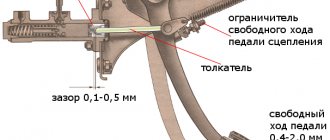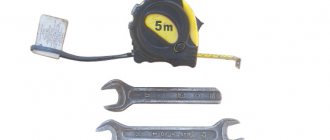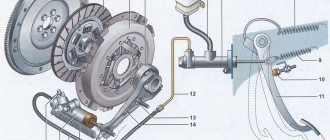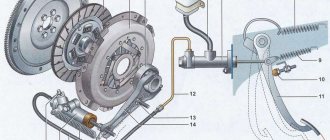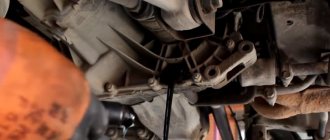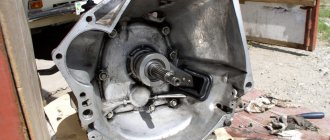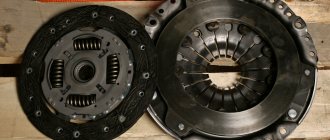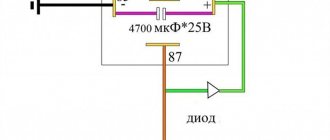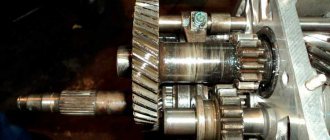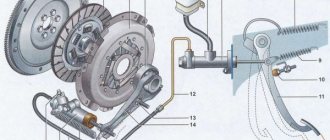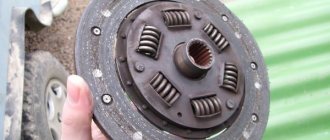The malfunction is expressed in the fact that the speeds begin to engage poorly and you often have to move the clutch fork, adjusting the free play. It deviates more and more from the release bearing along the crack that has formed and adjustments last for several days, and sometimes even a day, depending on the condition of the fork crack.
Typically, such a replacement is performed by removing the gearbox from the car, which is both expensive and quite labor-intensive. However, there is a way to replace the clutch fork
without removing the gearbox, which seems more acceptable for car enthusiasts.
The operation of replacing the clutch fork is not extremely difficult and is quite within the capabilities of any car enthusiast, provided that he is not afraid of work and is confident in his abilities.
Preparing for work
To replace the clutch fork, you need to purchase a new fork and process it in a certain way, namely. The ends of the fork are processed on a grindstone at an angle (about 45˚) so that the fork can fit under the pressure spring on the release bearing hub. Also, for ease of operation, you need to make a hook for prying the wire spring under the release bearing when installing the fork.
Before performing work, you must make sure that the clutch fork definitely has a defect in the form of a crack. To do this, you need to remove the clutch slave cylinder along with the rod and move it to the side on the hose. Then remove the protective cover of the plug and use a flashlight or carrier to look inside.
If the crack is not visible, then you need to press the fork leg with your hand in the direction it operates, which will immediately show where the crack is. Once you are sure that the fork is cracked, you can safely remove it from the clutch housing window.
Next, to consciously perform work with the clutch fork removed, look inside the clutch housing again. Having first turned the clutch fork over, you will see a strip of spring steel in the form of a rounded letter “P”, it serves to fix the fork to the clutch housing.
Now, looking inside the casing, you will see the fork support pin with a ball-shaped head. So your task is to get the fork locking petals under this ball.
Let's look further. On the gearbox input shaft guide we see the release bearing hub with a bearing and a wire spring. Your task is to get the sharpened ends of the fork under this spring so that the fork legs are between the spring and the hub. In this case, you first need to get the fork clamp under the head of the strut (ball), and only then place the fork under the wire spring of the release bearing hub.
If there is an old gearbox in the garage, then you can practice on it, where all your actions will be clearly visible.
This, of course, is an ideal option, but in reality you will have to make several attempts before you can get the fork into place.
It is more convenient when installing the fork, when you have put its internal lock on the ball of the strut and accurately brought both legs of the fork under the wire spring, hit the fork leg. Sometimes you can do this on the first try, but it depends on your luck.
In order for the insides to be clearly visible, you can use a flashlight, lowering it on a tie into the basket casing. Its light will be more than enough to get the job done. Then everything depends on your dexterity. The main thing is not to rush and everything will work out for you. This method has been tested many times and has always had a 100% positive result.
- Home
- Auto garage
- How to change the clutch fork on a VAZ 2106
Replacing the VAZ clutch fork
Clutch device VAZ 2107
The clutch is controlled by a pedal inside the cabin. When you press it, the clutch is disconnected from the gearbox, and when you press it, it engages. This ensures a smooth start of the car from a standstill and silent gear shifting. The node itself consists of a large number of elements interacting with each other. The VAZ 2107 is equipped with a single-disc clutch with a central spring .
Clutch basket
The clutch consists of two discs and a release bearing. The clutch used on the VAZ 2107 is simple and reliable. The pressure (drive disk) is installed on the flywheel. Inside the basket there is a driven disk connected to the gearbox input shaft with special splines.
The clutch can be single-disc or multi-disc. The first is considered more reliable. The clutch functions as follows. When you press the pedal, the release bearing mounted on the input shaft pulls the petals of the basket towards the engine block. As a result, the basket and driven disk are disengaged, and it becomes possible to change speeds.
For the VAZ 2107, wheels from the VAZ 2103 (for engines up to 1.5 liters) and VAZ 2121 (for engines up to 1.7 liters) are suitable. Externally they are very similar and have a diameter of 200 mm. These discs can be distinguished by the width of the linings (29 and 35 mm, respectively) and the presence of a 6 mm mark in one of the grooves of the VAZ 2121 damper.
Clutch disc
The driven disc is sometimes called a drum. There are pads glued to it on both sides. To increase elasticity, special slots are made on the disk during the manufacturing process. In addition, the drum is equipped with eight springs located in the plane of the disk. These springs reduce the frequency of torsional vibrations and reduce dynamic loads.
The drum is connected to the gearbox, and the basket is connected to the engine. During movement, they are pressed tightly against each other, rotating in the same direction.
The single-disk scheme used on the VAZ 2107 is distinguished by its reliability, comparative cheapness and ease of maintenance. This clutch is easy to remove and repair.
The driven disk for a 1.5 liter engine has dimensions of 200x140 mm. It can also be installed on a VAZ 2103, 2106. Sometimes a drum from a Niva (VAZ 2121) is installed on a VAZ 2107, differing in size (200x130 mm), a reinforced damper system and a large number of rivets.
Release bearing
The release bearing, being the most vulnerable element of the clutch, turns the rotation gear on and off. It is located in the middle of the disc and is rigidly connected to the pedal through a fork. Each press of the clutch pedal loads the bearing and shortens the bearing's life. Do not press the pedal unnecessarily. A bearing is installed on the gearbox drive shaft guide.
In the clutch kit, the release bearing is designated 2101. A bearing from a VAZ 2121, designed for high loads and having an increased service life, is also suitable. However, in this case, you will also need to replace the basket, since pressing the pedal will require great effort.
Clutch fork
The fork is designed to disengage the clutch when the clutch pedal is pressed. It moves the release bearing and, as a result, the inner edge of the spring.
Most often, if the fork is faulty, it becomes impossible to disengage the clutch. However, sometimes it continues to malfunction. If you do not replace the fork right away, you will have to replace the entire clutch assembly later.
Replacing the clutch fork on VAZ 2106-07, 2110-2112 cars
The clutch fork performs the function of disengaging it (hence the name release fork, or clutch drive fork). This is a kind of lever, when acted upon, the pressure plate is retracted and the clutch is disengaged. It can also be called a clutch engagement fork, because with the reverse action, when you release the pedal, the fork engages it.
This part is usually found in manual transmissions, and much less often in hydraulically driven gearboxes. Let's look at the design of the clutch fork using the example of cars from the VAZ 2110-2112 and VAZ 2106-2107 families. The fork consists of a lever and two legs attached to a metal rod.
The classic clutch fork looks a little different.
Symptoms of a faulty plug
Like any other part, it is subject to wear, and manufacturing defects are also possible (however, it is extremely rare due to the simplicity of the design). When the fork breaks right away, the pedal simply sinks and it is unlikely that you will be able to continue moving. But it happens that a crack appears in the fork, and then the clutch begins to grasp lower and lower, and adjustment helps only for a short time, and as the crack expands (increases), the pedal drops again.
Simplicity is simplicity, but replacing this part results in a rather troublesome task, since replacing the clutch fork entails removing the gearbox. If on a classic (VAZ 2016-07) you can try to carry out this procedure without removing the gearbox, as some sources claim, then with the front-wheel drive VAZ family this is completely excluded.
Replacing the fork on 2106, 2107
On classics, a cracked fork is a fairly common occurrence, and car enthusiasts have gotten used to changing it without removing the box. To do this, the ends of the new fork are ground at an angle of 45 degrees so that it can fit under the pressure spring. A hook with the end bent 5 centimeters would also be useful; we will use it to hook the spring. We need to get under the fork support pin (bolt with a ball head), and the paws get between the release bearing hub and the spring. After a certain number of attempts, their number depends on your accuracy and patience, the clutch fork will fall into place.
It is worth noting that on GAZelle cars it is also possible to replace this part without removing the box, using the method described above. For a GAZelle with a 402 series engine, this is generally a weak point, and owners of these models constantly complain about a weak fork and its constant breakdown. One solution to this problem is to install a reinforced fork from another model (Valdai), but it also has its own subtleties and nuances that are undoubtedly worth studying before proceeding with the replacement procedure.
Replacing the clutch fork on 2110, 2112
First of all, remove the clutch fork pressure spring. After this, remove the plastic shaft retaining sleeve and the fork boot. Now you can carefully remove it. Be sure to check the condition of the bushings, both the lower metal and upper plastic, and, if necessary, replace them if there is severe wear. The boot also does not interfere with inspection for breaks.
We install the new fork in the reverse order, not forgetting to lubricate the bushings first.
How to change the fork
clutch for VAZ 2110
Troubleshooting vehicle systems, including clutch
, primarily provides diagnostics. It is performed with serious disruptions in the operation of vehicle components. The discovery of a fault in the clutch system will most likely entail a complete replacement or individual components.
The availability of precise recommendations from automakers and mechanical engineers provides information on when and when to replace the clutch and its parts. However, regulated conditions in real life depend to a greater extent not on the recommendations of specialist developers, but on the driving method, the level of load during auto operation and other factors.
Clutch selection
When purchasing a new clutch kit for the VAZ 2107, experts recommend being guided by the following criteria. When assessing the driven disk:
- the surface of the linings must be smooth and uniform, without scoring, cracks or chips;
- all rivets on the disk must be the same size and located at an equal distance from each other;
- there should be no oil stains on the disc;
- there should be no play in the places where the linings and springs are attached;
- The manufacturer's logo must be applied to the product in one way or another.
When choosing a basket, you should pay attention to the following points:
- the casing must be stamped, without cuts or scratches;
- the surface of the disk must be smooth and uniform, without cracks or chips;
- the rivets must be identical and strong.
Master disk resource
How long does this element last? Manufacturers do not provide exact data.
But as practice shows, the average life of the drive disk is from 100 to 150 thousand kilometers. Below we note several factors that significantly reduce its resource:
- Aggressive driving style. Constant movements at high speeds with a sharp release of the pedal have an adverse effect on the condition of the friction linings.
- Driving with a load. This is especially true for commercial vehicles. For example, let’s take the GAZelle, whose gearbox is no different from the Volgov’s. This kind of drive is simply not designed for high loads. Even when the pedal is released smoothly, the friction material will slip through the flywheel and simply burn due to friction. The resource of such a disk is not even 15 thousand kilometers. The same goes for the trailer. Do not overload the mechanisms - the clutch, master cylinder and much more will suffer.
- Incorrect towing. You should not pull a car that weighs one and a half or more times the weight of your car. This will quickly burn out the drive disk.
So, we have found out the main clutch malfunctions and methods for eliminating them.
Clutch replacement
If the clutch begins to slip, it needs to be replaced. It is more convenient to do this on a lift or overpass. As a last resort, you can use a jack with mandatory protective stops. To replace you will need:
- standard set of screwdrivers and wrenches;
- pliers;
- clean rag;
- mount;
- mandrel.
Removing the gearbox
When replacing the clutch on a VAZ 2107, the gearbox does not need to be completely removed, but only moved enough so that the input shaft disengages from the basket. However, most often the box is completely dismantled. In addition to convenience, this allows you to check the condition of the crankcase and seals. The gearbox is removed as follows:
Removing the disc basket
After dismantling the gearbox, the basket with the disc is removed in the following order.
- The flywheel is secured against turning with a pry bar.
- Use a 13mm wrench to unscrew the basket mounting bolts
Removing the release bearing
After the basket, the release bearing is removed. This is done as follows.
- Using a screwdriver, press the antennae of the fork that engages with the bearing.
After removal, the retaining ring is checked for damage and, if necessary, replaced with a new one. If the ring, unlike the bearing, is in good condition, it can be reused with a new bearing.
Installing the drive cage
With the clutch and gearbox removed, the condition of all exposed components and parts is usually checked. The disc and flywheel mirrors should be lubricated with a degreaser, and CV joint-4 grease should be applied to the shaft splines. When installing the basket, you should pay attention to the following points.
- When installing the basket on the flywheel, align the centering holes of the housing with the flywheel pins.
When installing a disk, it is inserted into the basket with its protruding part.
When mounting the disk, a special mandrel is used to center it, holding the disk in the desired position.
The procedure for installing a basket with a disk is as follows.
- A mandrel is inserted into the flywheel hole.
Installing the release bearing
When installing a new release bearing, follow these steps:
- Litol-24 lubricant is applied to the spline surface of the input shaft.
A correctly installed release bearing, when pressed by hand, will move the clutch fork.
What's the result?
As you can see, during the operation of the car the clutch fork is subject to wear. Although a high-quality part lasts quite a long time, by 100 thousand km the fork may fail. Even if during the inspection it was not possible to find cracks or other defects, there is a high probability of wear of the paws. In any case, the part requires replacement.
Finally, we note that quite often, along with the clutch fork, the clutch will also require replacement. The area where the fork contacts the surface is also where wear occurs. For this reason, you should make sure in advance that it is advisable to solve the clutch problem only by replacing one fork. Otherwise, you will need to re-disassemble the clutch mechanism, install a release bearing, etc.
The clutch pedal is tight, the clutch is pressed hard: the main causes of the malfunction. Diagnosis of clutch problems and repair. Tips and tricks.
The clutch pedal has fallen: why does this happen? The main reasons why the clutch pedal fails, what should the driver do if the clutch fails.
Types of clutch drive. If the clutch pedal falls, the clutch has become soft, problems have arisen with the clutch: causes and repair of major faults.
How to adjust the clutch pedal, what adjustment is needed for: clutch functions, clutch pedal adjustment (free play and total travel).
Car clutch and design overview: clutch pressure plate, driven disc, release bearing. Types of clutch drives on manual transmissions and manual transmissions.
Car clutch: purpose, types, design, principle of operation. Frequent clutch malfunctions in the vehicle transmission system, signs of problems.
Looking for problems
So, you understand that the fork is an important part and that is why you need to be able to determine whether it is faulty or not. The easiest way is knocks and noises, but it also happens that a burning smell appears. This is due to the fact that the disk has undergone deformation for some reason, but sometimes this is due to poor mounting of the engine and gearbox. Your task is to replace this part and improve the fastening.
Parts that are damaged must be replaced. In the event that there is towing, you can immediately blame the cylinders or fluid. Hydraulic fluid has most likely leaked or there are problems with the correct operation of the cylinders. If you have poor pedal response, the problem is most likely a bearing or lever issue. In this case, only replacement will help.
The concept and principle of operation of the clutch and its components
The clutch is a special system device that connects the engine and transmission. It performs important functions in a car. First of all, it transmits torque. However, in addition to this, it protects the engine and transmission from any damage or stress. Thus, it prolongs their performance.
There are several types of clutch mechanism. The most common type is friction. Its design is quite simple, and the principle is that it works due to friction. There is also a hydraulic mechanism, which is based on a special hydraulic fluid that powers the mechanism. And finally, the last type is the electromagnetic clutch. The essence of its work is that it uses an electromagnetic field to activate the entire clutch mechanism. There are cases when a combined type of clutch occurs, which combines two main types.

